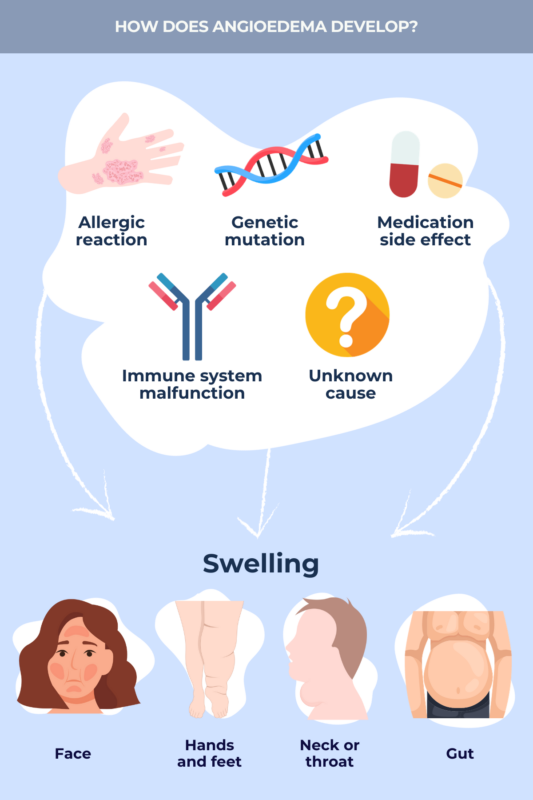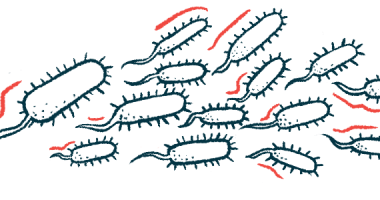Angioedema overview
Angioedema is a form of swelling that occurs in the deeper layers of the skin or in mucus membranes.
There are several types of angioedema. All of them are marked by swelling, but the specific underlying angioedema causes vary. Some forms of angioedema are associated with an allergic reaction or occur as a side effect of certain medications, while others arise due to genetic mutations or in association with other health conditions. In some cases, angioedema may have no clear cause.
Although swelling is considered the hallmark symptom of angioedema, it also may be accompanied by other symptoms, including rash, itchiness, fatigue, or abdominal pain. The specific pattern of angioedema symptoms a patient experiences, along with the person’s medical history, can be key to diagnosing the specific type of angioedema. That diagnosis is needed, in turn, to determine the best course of angioedema treatment, or means of prevention of swelling attacks.
Types and causes
There are five main types of angioedema, each associated with a different cause.
Acute allergic angioedema
The most common disease type is acute allergic angioedema. In this angioedema type, swelling occurs as a consequence of an allergic reaction, which can be triggered by exposure to certain foods (e.g., nuts, eggs, shellfish, milk), medications (e.g., aspirin, penicillin), or even some materials (e.g., latex).
Drug-induced nonallergic angioedema
Drug-induced nonallergic angioedema refers to a form of the disease in which swelling and other angioedema symptoms occur as a side effect of a medication.
A particular class of medicines used to lower blood pressure, called angiotensin-converting enzyme (ACE) inhibitors, are the most common cause of drug-induced nonallergic angioedema. These medications include lisinopril — marketed as Zestril, among others — and enalapril, marketed as Vasotec and others.
Another class of blood pressure-lowering medications, called angiotensin receptor blockers, also can be one of the key causes of this type of angioedema. Among these medications are losartan, marketed as Cozaar and others, and valsartan, sold as Diovan, among others.
Hereditary angioedema
Hereditary angioedema, commonly referred to as HAE, is a rare chronic form of angioedema characterized by recurrent swelling attacks that occur due to genetic mutations.
In the vast majority of cases, HAE is caused by mutations in the SERPING1 gene, which provides instructions for making a protein called C1 esterase inhibitor, known as C1-INH. This protein normally helps regulate the levels of bradykinin, a signaling molecule that can trigger swelling. Low C1-INH activity in HAE causes bradykinin levels to rise too high, ultimately leading to swelling attacks.
In rarer cases, HAE also may be caused by mutations in other genes, such as F12, that result in an overproduction of bradykinin without affecting the levels or activity of the C1-INH protein.
Acquired angioedema
Similar to the most common forms of hereditary angioedema, acquired angioedema is marked by abnormally low activity of the C1-INH protein, which results in the overproduction of the swelling-promoting signaling molecule bradykinin.
In acquired angioedema, low C1-INH levels and activity are caused either by an autoimmune attack that targets the C1-INH protein itself, or as a consequence of another underlying condition such as cancer or an immune cell disorder.
Idiopathic angioedema
The term “idiopathic” means “of unknown origin.” Idiopathic angioedema is diagnosed when a person is experiencing swelling, but the specific underlying cause cannot be determined and all other angioedema types have been ruled out.
Symptoms and diagnosis
In all forms of angioedema, swelling can affect any part of the body. Typically, though, it most commonly occurs in the:
- face (lips, eyelids, mouth, or tongue)
- extremities (hands or feet)
- neck or throat
- bowel
- genitals
Swelling in the gastrointestinal tract also can cause digestive problems, such as abdominal pain, nausea, vomiting, diarrhea, or bloating.
If swelling occurs in the throat, it can block a person’s airway and cause problems breathing. This is a medical emergency that can be life-threatening; anyone experiencing swelling in the throat or difficulty breathing should seek immediate medical care.
While swelling occurs in all forms of angioedema, other symptoms also can accompany or precede swelling. Specific experiences of angioedema are unique from person to person, but some symptoms tend to vary by type.
For instance, in acute allergic angioedema, swelling is often accompanied by itching and hives, known as urticaria. But these symptoms are not typically seen in other forms of angioedema.
People with HAE, meanwhile, may experience some prodromal symptoms — early signs of the disease — such as fatigue, muscle aches, and a rash in the lead-up to a swelling attack.
Assessing the specific pattern of symptoms in each patient and reviewing the person’s past clinical and family history is typically a key part of diagnosing the type of angioedema. Certain lab measures, including blood, allergy, and genetic tests, also can be used to confirm an angioedema diagnosis.
Because treatment strategies vary, correctly diagnosing the specific type of angioedema is key for making a long-term care plan to minimize the risk of future swelling episodes.

Treatment
Angioedema treatment depends on the type and underlying cause of the disease.
For acute allergic angioedema, treatment generally involves the use of medications like antihistamines or corticosteroids that provide relief by tamping down the allergic reaction that caused swelling.
Similar medicines may be used in the short-term to help manage swelling that develops as a side effect of certain medications. Typically, however, discontinuing the drug causing the side effect — and finding a suitable replacement — is usually the main method used for long-term treatment of drug-induced nonallergic angioedema cases.
A number of medications are available to help treat hereditary angioedema by increasing C1-INH activity and/or lowering bradykinin levels. Some of these therapies may be used on-demand to control swelling, while others are taken prophylactically, or preventively, to reduce the risk of angioedema attacks. Approved treatments for HAE include:
- Andembry (garadacimab-gxii)
- Berinert (human C1 esterase inhibitor)
- Cinryze (human C1 esterase inhibitor)
- Dawnzera (donidalorsen)
- Ekterly (sebetralstat)
- Firazyr (icatibant)
- Haegarda (human C1 esterase inhibitor)
- Kalbitor (ecallantide)
- Orladeyo (berotralstat)
- Ruconest (recombinant C1 esterase inhibitor)
- Takhzyro (lanadelumab-flyo).
On-demand treatments used in HAE also may be used to manage acute swelling attacks in acquired angioedema. Long-term management of acquired angioedema, meanwhile, generally focuses on treating the underlying disorder (e.g., chemotherapy for acquired angioedema associated with cancer).
Prevention
Apart from medications to control acute swelling, taking steps to prevent future angioedema attacks is a key part of disease management in chronic types of the condition.
A main goal of angioedema prevention is limiting exposure to substances that can trigger an attack. For people with acute allergic angioedema, this typically means identifying and then avoiding the substance causing the allergy. For those with drug-induced nonallergic angioedema, it generally entails discontinuing treatment with the offending medication and finding a suitable alternative.
People with hereditary angioedema often find that their attacks are triggered by things such as infections, stress, or injuries. Avoiding such triggers is a key aspect of managing the disease, and it’s recommended that patients keep a diary or journal to record swelling attacks so that they can identify potential swelling triggers.
Life expectancy
Although angioedema can be painful or uncomfortable, the vast majority of cases are not serious, and deaths due to angioedema are very rare. A 2020 study done in Italy found that people with hereditary angioedema have a similar life expectancy to the general population.
The only time angioedema is considered life-threatening is if swelling occurs in the throat and blocks the airway, which can cause fatal suffocation or asphyxiation. A review of real-world data, done in 2021, indicated that swelling in the throat was fatal in about 5% of patients with hereditary angioedema experiencing this type of swelling.
In general, people with angioedema are less likely to experience fatal disease complications if the type of angioedema is correctly identified early on. This allows patients and clinicians to create a plan to prevent and treat swelling, minimizing the risk of serious health problems.
Angioedema News is strictly a news and information website about the disease. It does not provide medical advice, diagnosis or treatment. This content is not intended to be a substitute for professional medical advice, diagnosis, or treatment. Always seek the advice of your physician or other qualified health provider with any questions you may have regarding a medical condition. Never disregard professional medical advice or delay in seeking it because of something you have read on this website.
Recent Posts
- Celebrating the steady rock who holds our family together
- Oral Ekterly gives relief to kids with HAE, trial data show
- Uncontrolled HAE attacks mean lower quality of life for patients
- Mycoplasma pneumoniae linked to rare case of acquired angioedema
- HAE therapy ADX-324 hits Phase 3 milestone with first treatment

 Fact-checked by
Fact-checked by 




